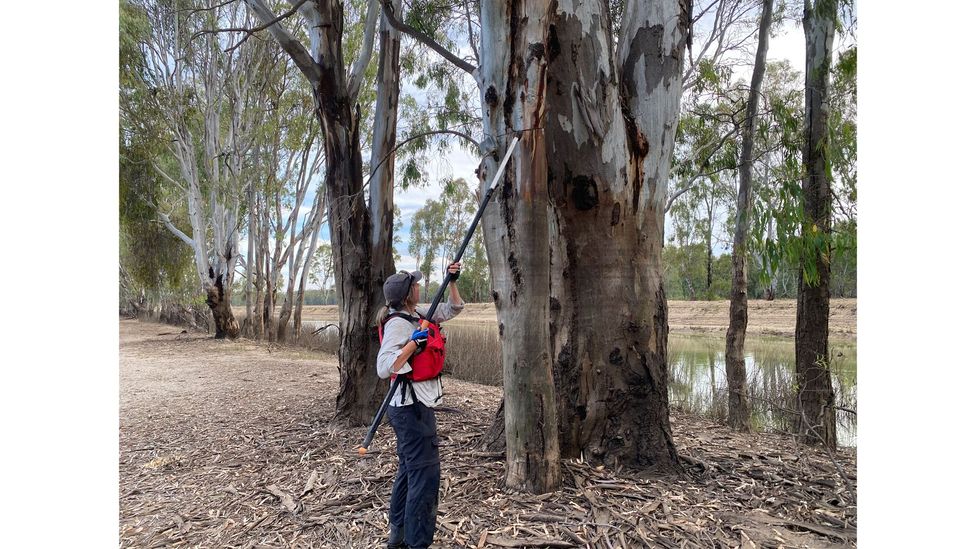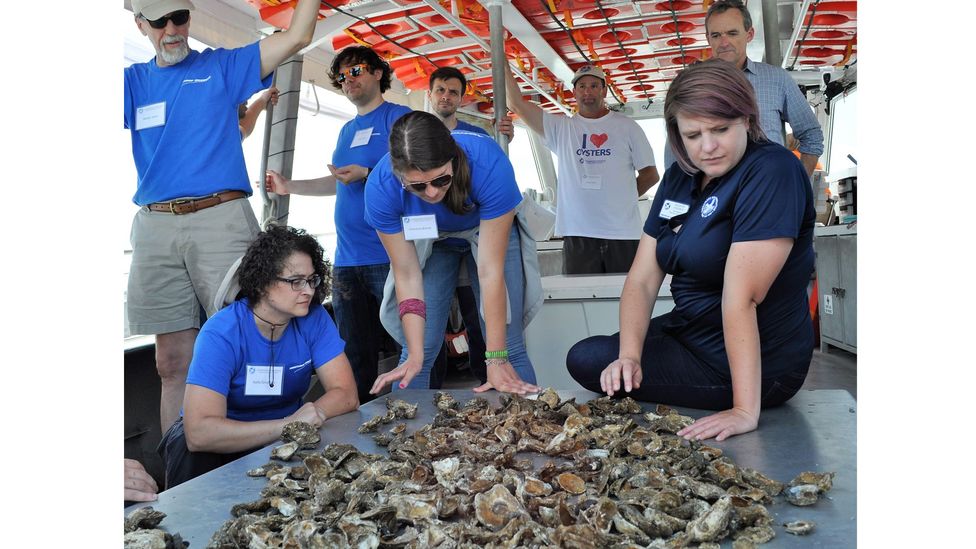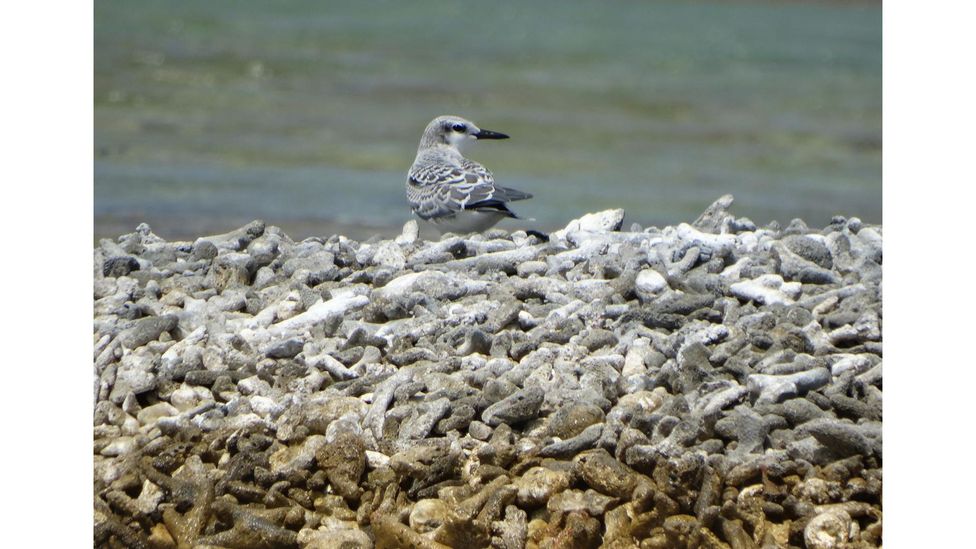Beyond human hearing, a cacophony of natural clicks, whistles and hums pass all around us, linking billions of living beings in networks of sound.
Mother whales whisper to their young so predators can't hear them. Bees emit unique buzzing signals to distinguish threats from specific predators. Turtle embryos synchronise their collective moment of birth by making sounds through their shells. And unknown fish species buzz to one another in the depths – their very identities one of nature's countless sonic mysteries.
Sadly, this sonic biodiversity, evolved over millions of years, is in decline. In the oceans, singing whales and vocalising fish populations are dwindling fast. Insect and bird calls are drowned out by the din of humans and lost to extinction. As species disappear so do their songs, rendering natural soundscapes homogeneous – and all too quiet.
But what if tapping into these sounds could allow us to not only to learn more about the natural world, but actually help to begin healing it? An emerging appreciation for the biological importance of sound has led to new strategies for environmental conservation. From microscopic larvae lost at sea to birds that travel hundreds of miles from home, conservationists are now starting to use the sounds of nature to guide them back to where they belong.
Eavesdropping on nature
"Sound is so important," says Cheryl Tipp, curator of wildlife and environmental sound at the British Library. "In the natural world, it's used in mating displays, in territorial disputes, as alarm signals."
For humans trying to support nature, meanwhile, sound can be used to identify new species, monitor populations and assess the health of ecosystems, she says.
Sound has long been used to observe the natural world, and advances in technology are now making passive acoustic monitoring increasingly accessible. Acoustic sensors are small, affordable and non-invasive – and can allow researchers to capture phenomena or species which would otherwise be difficult to observe, such as species that live in forest canopies or the deep sea, or are at times inaccessible due extreme weather. Technology can listen where humans cannot.

Elizabeth Znidersic cuts down an acoustic recorder down from a tree following a flood (Credit: Charles Sturt University)
More recently, though, scientists have begun to investigate ways sound can be used to actively elicit certain behaviours in animals. In a 2020 paper, for example, researchers described how they played recordings of rainfall to trigger breeding in frogs.
There is now a growing interest in the use of sound to accelerate habitat restoration itself, by coaxing certain species to certain locations using their very own sounds. Scientists have successfully used "acoustic lures" to guide species – including bats, fish and whales – to or away from specific locations.
Highways of sound
"When you work on a shoestring, you have to think creatively," says Dominic McAfee, a marine ecologist from the University of Adelaide in Australia.
In 2015, McAfee and his colleagues began restoring oyster reefs off the coast of Australia using underwater speakers they made themselves to encourage wild oyster larvae back to the area to settle on the newly restored habitat.
Centuries of over-harvesting, habitat degradation and disease have pushed the global oyster population to the brink of extinction – with at least 85% of reefs lost in the past 150 years.
"The reefs were destroyed by dredge fishing," says McAfee. "They scraped all the oysters from the sea floor so there was no hard substrate left for them to regenerate on."
The conventional way to restore these reefs is the "spat on shell" strategy, where oyster larvae are bred in hatcheries, settled on other oyster shells – at which point they become known as "spat" – then placed on the seabed. But this is an expensive process, says McAfee, with a low success rate.
Instead, McAfee set his sights on attracting any of the few oyster larvae left in the ocean – by giving them "highways of sound" to follow. There was some research showing that in the presence of certain sounds, oyster larvae will dive to the seabed. MacAfee saw a potential for this technique to draw wild oyster larvae in from further afield.
Initially, McAfee and his team began playing various soundscapes to oyster larvae in the lab, and saw that they did indeed move towards some sounds more than others. "We played them the sounds of seagrass meadows, healthy rocky reefs, degraded rocky reefs – and we quickly recognised what music oysters like. The healthier the habitat sound, the more vibrant, the more biologically active, the stronger the attraction." The baby oysters are drawn to the sound of snapping shrimp, which indicates a healthy reef.
Next, the team built an "oyster raceway" – a tank in the lab – and discovered these microscopic creatures were able to swim across metres towards the source of the sound.
"This sort of active dynamic movement, interacting with environmental cues, had never been seen before," he says.
When the team then put boulders down in the ocean, they were shocked by the results.
"The larvae seem to travel in packs," says McAfee. "They move through the water column in clumps – which is phenomenal. I don't know how they do that. Hundreds and hundreds of millions settled almost immediately."
The study, published in 2022, suggests that, in the case of oysters at least, playing the sounds of the sea is an effective technique for restoration. "Within just a few short years we've brought an extinct ecosystem back from the dead," says McAfee.
You might also like:
- Why the Alps are a haven for rare butterflies
- The vegan leather made from India’s waste flowers
- The doctors prescribing 'blue' therapy
McAfee now feels there is little point using expensive hatchery techniques, only to put down a few million oysters.
However, there is still much learn about using acoustic lures in this way. For instance, could the technique create habitat sinks where isolated populations cannot survive? MacAfee thinks that might be an issue for dynamic disperses like fish – which need to seek out more of their own species to breed – but that wouldn't be the case for oysters which have been seen to form self-sustaining populations in newly restored habitats.
The idea of coaxing back oysters with sound is spreading across oceans.
The Chesapeake Bay basin – spanning 64,000 sq miles (166,000 sq km) stretching across six eastern US states – was once the site of a tremendous oyster population.
"The oysters could, at one point, filter the entire volume of the bay in three days," says Allison Colden, Maryland executive director for the Chesapeake Bay Foundation (CBF). "This now takes over a year because of the loss of the oyster population."

Oysters improve water quality and clarity and form biogenic reefs which provide habitat for other species (Credit: AJ Metcalf)
Oysters, says Colden, are important. They improve water quality and clarity. They also form biogenic reefs – hard structures which are the temperate equivalent of coral reefs in the tropics –providing habitat for other species.
In 2018, CBF founded the Chesapeake Oyster Alliance, which aims to add 10 billion oysters to the Bay by 2025.
In the past decade, the bay's oyster population has gone from "on the brink" to thriving. Now they have healthy reef soundscapes to record and play back using McAfee's method, says Colden, the project is hoping to accelerate the rate of restoration even more.
"My entree into the world of using soundscapes [for restoration], particularly with oysters, is relatively recent – but if there is enough larvae out in the water, it would mean an enormous cost saving," she says. "It takes millions of dollars per year to produce the volume of the spat on shell product that we typically use in restoration."
Carbon Count
The emissions from travel it took to report this story were 0kg CO2. The digital emissions from this story are an estimated 1.2g to 3.6g CO2 per page view. Find out more about how we calculated this figure here.
Colden's team also plan to introduce lab-grown larvae directly into the water above some newly restored habitats where there may not be enough existing larvae.
"By deploying the soundscape projection, we can ensure that the larvae we release have the best chance of making it to the reef," she says.
However, Colden is cautious.
"When you're working in shallow nearshore environments, as we are in an estuary, you have to compete with a lot of boat noise – recreational boat noise and shipping. I imagine that it could be very difficult." (Read more about how ocean noise affects wildlife and some of the simple ways we could tackle this overlooked pollution problem).
It's also important to avoid any possible negative impacts for other species such as marine mammals, she adds. "We're being mindful of making the environment even more noisy than it already is."
Seabird discotheque
It's not just oysters that conservationists are using sounds to attract. Almost 6,000 miles (9,700km) away from Chesapeake Bay basin, a raucous disco blasts from the shores of a pacific paradise – calling for lost bird species who could be hundreds of miles out to sea.
Palmyra Atoll is among the most isolated places on Earth, sitting more or less in the centre of the Pacific Ocean. During World War Two, US military ships brought black rats to the atoll. The rats thrived, multiplying fast as they fed on native shellfish, plants and seabird young. Thanks to a huge conservation effort, Palmrya was finally rid of the rats by 2011. (Read more about the rats evicted from paradise).
But it was left with a void. There was an eerie quiet – and eight missing seabird species.
"When they're out at sea, seabirds forage on fish, squid and plankton," says Alex Wegmann, lead scientist for The Nature Conservancy, a non-profit environmental organisation that bought the atoll from private owners in 2000 and now manages a nature preserve there. "Those marine organisms are rich in nitrogen and phosphorus – which the birds bring back, digest and poop out."
Seabirds, says Wegmann, therefore act as a vital nutrient delivery service for these remote places, providing the materials from which ecosystems can grow. They also make an awful lot of noise. "Healthy island ecosystems are deafening," he says. "They're so loud. There's just constant persistent noise all the time."
Sound systems blaring out the calls of missing species is one kind of "social attraction" technique, along with plastic decoys and mirrors angled on the shoreline. All these have shown success in restoring lost ecosystems.
So in 2020, armed with a pair of solar-powered loudspeakers and an MP3 player, Wegmann and his team set up a "seabird discotheque" to blast out bird calls 24/7 in an attempt to guide the eight missing seabird species home.
"We were hoping for any one of these species passing by to hear it and think, 'I recognise that. I'll go and check it out'," says Wegmann. "Then maybe it would stay. And if two of them came, maybe they would nest. There were a lot of maybes and ifs."
With the sound blasting just 500m (660ft), and competing with the surf and wind, the chances of success may have seemed slim.
But a grey-backed tern did return, and then another came. And the pair have produced a chick – named Myra after the daughter of the researcher who first spotted it, who is named after the atoll itself.

Following the use of the loudspeakers, two grey backed terns returned to Palmyra and produced a chick, named Myra Jr (Credit: The Nature Conservancy)
"That chick is still, as of last week, running around at the nesting site – the first evidence of success of our seabird recovery programme," says Wegmann.
From the ground up
As these initial promising results trickle in, some researchers want to take the idea one step further – suggesting that eco-acoustics could help restore whole ecosystems.
The downsides of nature recordings?
While studies are showing sound recordings can be used to attract nature back to where it should be, there are concerns that they are not always helpful for nature. In a 2013 study looking at wrens in Ecuador, researchers warned about the potentially negative impacts, such as inducing stress or diverting time from other activities, on the use of recorded vocalisations to attract birds by recreational birdwatchers.
Following large-scale disasters like forest fires, coral bleaching, blackwater events or catastrophic storms, a habitat may be restored through revegetation. But while "it might look great, it doesn't sound right", says Elizabeth Znidersic, an ecologist at the Charles Sturt University in Australia.
Znidersnic and her team propose playing audio recordings to attract whole communities of different species.
"Sound is one of a layer in a whole host of techniques used for restoration," says Znidersnic. "But even if the vegetation isn't there, sound is an invitation to come – to poop, to drop the microbial stuff that can kickstart regeneration."
Crucially, she says, by increasing the number of animals merely passing through, the seeds, spores, bacteria and fungi they carry will be reintroduced to the area, fast-tracking recovery of entire food webs from the ground up.
Efforts are now accelerating across the globe to record and collect the different sounds of nature. Perhaps these may even end up playing a vital role in restoring ecosystems that are lost in the future – if we can act fast enough before species vanish from the Earth for good.
Tipp, from the British Library, tells me that sound has become a vital element of conservation. "It's essential for researchers to have a bank of recordings to draw upon. Recording the sounds of the planet has never been so important, when so many species are facing extinction."
--
Join one million Future fans by liking us on Facebook, or follow us on Twitter or Instagram.
If you liked this story, sign up for the weekly bbc.com features newsletter, called "The Essential List" – a handpicked selection of stories from BBC Future, Culture, Worklife, Travel and Reel delivered to your inbox every Friday.
"sound" - Google News
May 20, 2023 at 02:00PM
https://ift.tt/gc0kNJ1
The scientists coaxing back nature with sound - BBC
"sound" - Google News
https://ift.tt/gD7h91p
Shoes Man Tutorial
Pos News Update
Meme Update
Korean Entertainment News
Japan News Update

No comments:
Post a Comment